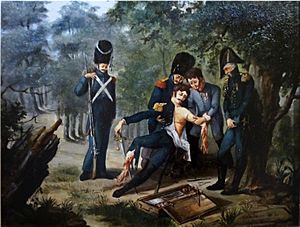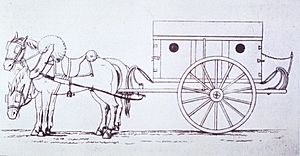Dominique Jean Larrey facts for kids
Quick facts for kids
Baron of the Empire
Dominique Jean Larrey
|
|
|---|---|

Portrait by Larrey's sister-in-law, Marie-Guillemine Benoist (1804)
|
|
| Born | 8 July 1766 Beaudéan, Bigorre (in present-day Hautes-Pyrénées)
|
| Died | 25 July 1842 (aged 76) |
| Nationality | French |
| Spouse(s) | Marie-Élisabeth Laville-Leroux |
| Scientific career | |
| Fields | Surgeon, Physician |
Baron Dominique Jean Larrey (8 July 1766 – 25 July 1842) was a French surgeon and military doctor. He became famous during the French Revolutionary Wars and the Napoleonic Wars. Larrey was a key inventor in battlefield medicine and triage. Many people see him as the first modern military surgeon.
Contents
Early Life and Medical Training
Larrey was born in a small village called Beaudéan in the Pyrenees mountains. His father was a shoemaker. When Larrey was 13, he became an orphan. His uncle, Alexis, who was a chief surgeon in Toulouse, then raised him.
After learning from his uncle for eight years, Larrey went to Paris. There, he studied with Pierre-Joseph Desault, a top surgeon at the Hôtel-Dieu de Paris hospital. Later, Larrey moved to Brest. He became a surgeon in the navy and started teaching. In 1787, at almost 21 years old, he was the youngest medical officer in the French Royal Navy. He sailed on a ship to defend Newfoundland. While in America, Larrey wrote about the local plants, animals, weather, and customs. These notes were published years later in his book, Mémoires de chirurgie militaire.
In 1789, Larrey was back in Paris. He worked with other important doctors at Les Invalides. On July 14, during the Storming of the Bastille, he quickly set up a way to help the wounded. This was an early form of an ambulance.
Revolutionary Wars and New Ideas
Larrey supported the ideas of the French Revolution. In 1792, he joined the French Army of the Rhine. This was during the War of the First Coalition. In Mainz, he met another famous doctor, Samuel Thomas von Sömmerring.
During this time, Larrey started new ways of doing army surgery. He created field hospitals and a system for army ambulances. He saw how fast the French flying artillery moved on battlefields. So, he changed their carriages into ambulance volantes (meaning "Flying ambulances"). These were used to quickly move wounded soldiers. They had trained drivers, medical helpers, and people to carry stretchers.
At the Battle of Metz in 1793, Larrey showed how useful his field ambulances were. The army's quartermaster-general, Jacques-Pierre Orillard de Villemanzy, ordered test models to be built. After this, all French armies were supposed to get ambulances. But politicians ordered a contest to find the best design. This delayed the ambulances for over two years.
Larrey also made field hospitals easier to move and better organized. This was like an early version of modern MASH units. He set a rule for treating war injuries, called triage. This meant treating the most seriously injured first, no matter their rank or country. Soldiers from enemy armies were treated just like French soldiers.
In 1794, he went to Toulon. There, he met Napoleon Bonaparte for the first time. He married the painter Marie-Élisabeth Laville-Leroux. He got sick in Spain and returned to Paris. For a short time in 1796, he taught anatomy at the Val-de-Grâce Medical School. Then, he became the chief surgeon for the French armies in Italy.
Larrey went with the Egyptian campaign in 1798. After the victory at the Battle of Abukir, he started a medical school for army doctors in Cairo. Many of his patients there had ophthalmy, an eye disease. Larrey studied this disease and wrote about it. He also improved how wounded soldiers were moved. He used dromedaries (camels) with two chests on each side of their hump to carry the injured. This was better than horses in the desert. He was hurt during the Siege of Acre. Larrey came back to France in October 1801.
Serving Napoleon in War
Larrey was made a Commander of the Légion d'honneur on May 12, 1807. He was at the Battle of Aspern-Essling. There, he operated on Marshal Jean Lannes and removed one of his legs in just two minutes. He became Napoleon's favorite surgeon. Napoleon once said, "If the army ever builds a monument to show its thanks, it should be for Larrey." Larrey was made a Baron on the battlefield of Wagram in 1809.
In 1811, Baron Larrey was part of the surgical team that performed a breast removal surgery on Frances Burney. This was done before anesthesia was used. His detailed notes about this surgery show what doctor-patient relationships and surgical methods were like in the early 1800s. Larrey also took part in the French invasion of Russia.

When Napoleon was sent to Elba, Larrey wanted to join him, but Napoleon said no. At Waterloo in 1815, Larrey showed great bravery under fire. The Duke of Wellington noticed this. He told his soldiers not to shoot in Larrey's direction. He wanted to "give the brave man time to gather up the wounded." Wellington praised Larrey's courage.
While trying to escape to the French border, Larrey was captured by Prussian soldiers. They wanted to execute him right away. But one of the German surgeons recognized Larrey and begged for his life. Larrey had once saved the life of Blücher's son. Blücher was a Prussian general. Because of this, Larrey was pardoned. He was invited to Blücher's dinner table and sent back to France with money and clothes.
Later Years and Legacy
Larrey spent the rest of his life writing. After Napoleon's death, he started a new medical career as chief surgeon in the army. In 1826, he visited England and was welcomed by British surgeons. In 1829, he joined the Institut de France. A year later, he became a member of the American Philosophical Society.
In 1842, he went to Algiers for a health inspection with his son. On his way back, he got pneumonia and died in Lyon on July 25. His body was taken to Paris and buried at the Père-Lachaise Cemetery. In December 1992, his remains were moved to Les Invalides. They were re-buried near Napoleon's tomb.
Larrey's writings are still important for surgical and medical knowledge. They have been translated into many languages. Between 1800 and 1840, he published at least 28 books or articles. His son, Hippolyte (born 1808), became the personal surgeon to Emperor Napoleon III.
NATO Award in His Honor
The Dominique-Jean Larrey Award is the highest medical honor given by the North Atlantic Alliance (NATO). It is given out every year by NATO's main medical group. This group is made up of the top military doctors from NATO and partner countries. The award recognizes someone who has made a big and lasting contribution to NATO's medical efforts. This could be by helping different countries work together or by improving healthcare in NATO missions.
See also
 In Spanish: Dominique-Jean Larrey para niños
In Spanish: Dominique-Jean Larrey para niños



